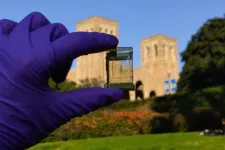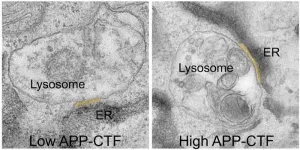(Press-News.org) Researchers developing the next generation of computing technology aim to bring some light to the field — literally.
Optical computing, which relies on particles of light called photons, is expected to provide alternatives to traditional electronic approaches. Such systems — or light-based components of hybrid systems that also retain electronic parts — could be faster, consume less energy and compute visual information more efficiently through simultaneous, parallel processing.
To date, optical computing has faced a limitation in achieving nonlinear responses, which means producing signals not directly proportional to the input. Nonlinearity makes universal computing applications, including artificial intelligence, possible.
Nonlinear materials and devices under development need a substantial amount of light to work. Previously, this required high-powered lasers that operate only in a narrow band of the electromagnetic spectrum; absorbing light over time, making processing slow; or using energy-inefficient materials that take in lots of light but preclude applications that require light efficiency or transparency.
Now, a recent collaborative study from members of the California NanoSystems Institute at UCLA, or CNSI, has introduced a device that overcomes these hurdles.
In a major step toward optical computing for processing visual information, the CNSI investigators showed that a tiny array of transparent pixels could produce a fast, broadband, nonlinear response from low-power ambient light. The team also demonstrated an application that combines their device with a smartphone camera to reduce glare in images. The study was published in Nature Communications.
“Optical nonlinearities are far behind what we need for visual computing applications,” said co-corresponding author Aydogan Ozcan, the Volgenau Professor of Engineering Innovation in the UCLA Samueli School of Engineering. “We need low-power, broadband, low-loss and fast nonlinearities for optical systems to meet our visual computing needs. This work helps fill that gap.”
Potential applications for the technology — beyond the glare reduction validated in the study — cross a variety of consumer and industrial uses: improved sensing for autonomous vehicles; cameras that recognize certain objects while hiding others; image encryption; and efficient, effective detection of defects in robotic assembly lines, among many others.
The device could offer many advantages. For example, the incoming images could be processed without conversion to a digital signal, speeding results and reducing the amount of data being sent to the cloud for digital processing and storage. The researchers envision linking their technology with cheap cameras and compressing data to produce images with vastly higher resolution than was realized before, and more precisely and accurately capturing useful information about the arrangement of objects in space and the electromagnetic spectra present in the light.
“An inexpensive device measuring a couple of centimeters could make a low-powered camera work like a super-resolution camera,” said Ozcan, a UCLA professor of electrical and computer engineering and of bioengineering, as well as an associate director at the CNSI. “That would democratize access to high-resolution imaging and sensing.”
The device in the study is a transparent plane measuring 1 cm square. It uses a 2D semiconductor material — rendered as a film only a few atoms thick — that was developed by co-corresponding author Xiangfeng Duan, a professor of chemistry and biochemistry in the UCLA College.
The thinness of the material makes it transparent, while it retains qualities that enable incoming photons to efficiently regulate electrical conductivity. The research team coupled the 2D semiconductor with a layer of liquid crystal and made it functional with an array of electrodes. The result is a smart filter comprising 10,000 pixels, each able to selectively and quickly darken in a nonlinear way when exposed to broadband ambient light.
“Basically, we want to use a material that does not absorb a lot of light, but still produces sufficient signal that can be used to process the light,” Duan said. “Each pixel can change from completely transparent to partially transparent to opaque. It only takes a small number of photons to change the transparency dramatically.”
The research was made possible by the Elman Family Foundation Innovation Fund at the CNSI. A grant enabled the recruitment of the study’s first author, postdoctoral researcher Dehui Zhang, who advanced the work as part of Ozcan’s and Duan’s research groups. Zhang, and the project, linked faculty members who had known each other as colleagues for over a decade but hadn’t previously explored how they could team up.
“This unique opportunity led to a very, very exciting collaboration,” Duan said. “It’s really a blast to think outside of our comfort zones. It showed me that, as a material developer, I can benefit from going beyond a fundamental study or proof of concept to explore applications.
“We hope to continue down this road,” he added. “This is just the beginning. There’s certainly a lot more to do.”
Other co-authors, all affiliated with UCLA, are doctoral students Dong Xu, Yuhang Li, Jingxuan Zhou, Yucheng Zhang, Boxuan Zhou, Peiqi Wang and Ao Zhang; postdoctoral researchers Yi Luo, Jingtian Hu, Xurong Li and Huaying Ren; Bijie Bai, who earned a doctoral degree in 2023; Mona Jarrahi, Northrop Grumman Professor of Electrical Engineering; and Yu Huang, professor and chair of materials science and engineering.
The study was partly supported by the Office of Naval Research.
END
Advance in light-based computing shows capabilities for future smart cameras
UCLA-developed experimental device demonstrates ability to reduce glare in images
2024-04-15
ELSE PRESS RELEASES FROM THIS DATE:
Q&A: How claims of anti-Christian bias can serve as racial dog whistles
2024-04-15
In a speech to a group of religious broadcasters in February, Donald Trump promised to create a task force to counter “anti-Christian bias,” which he said would investigate the “discrimination, harassment and persecution against Christians in America.”
It’s not the first time Trump has claimed that Christians are being persecuted, and he’s not alone. As more politicians repeat these statements, researchers from the University of Washington investigated whether anti-Christian bias claims can also be ...
Three advances in pavement technology — for safer, more sustainable roadways
2024-04-15
While April showers bring May flowers, these months also kick off road construction season — when cracks and potholes that developed over the winter get fixed. But recent advances could make future roadways safer and repairs more sustainable, thanks to smart pothole monitoring, snail shells and graphene. The new approaches can be found in three papers recently published in ACS journals. Reporters can request free access to these papers by emailing newsroom@acs.org.
A smart pothole monitoring system for cars. By harnessing the vibrations that shake a vehicle as it drives over uneven pavement, researchers have created a system that ...
Civil engineer looks to remedy inequities in traffic safety
2024-04-15
Alyssa Ryan, an assistant professor of civil and architectural engineering and mechanics, in the University of Arizona College of Engineering, is leading a national study to identify disparities in traffic safety for all transportation users, including drivers, bicyclists and walkers.
"Transportation engineering is very focused on people and impacting society and how people interact with the world," said Ryan. "If you don't have transportation, you can't do anything."
With a $467,000 ...
New research highlights effects of gentrification on urban wildlife populations across U.S. cities
2024-04-15
Chicago (April 15, 2024) – New research published on Monday, April 15 in the Proceedings of the National Academy of Sciences of the United States of America (PNAS) identifies how gentrified parts of a city have notably more urban wildlife than ungentrified parts of the same city, further limiting marginalized communities’ opportunity to connect with nature. The study, led by Lincoln Park Zoo’s Urban Wildlife Institute, analyzed data from 23 cities across the continental U.S., collected by partners of the Urban Wildlife Information Network ...
Vaccine breakthrough means no more chasing strains
2024-04-15
Scientists at UC Riverside have demonstrated a new, RNA-based vaccine strategy that is effective against any strain of a virus and can be used safely even by babies or the immunocompromised.
Every year, researchers try to predict the four influenza strains that are most likely to be prevalent during the upcoming flu season. And every year, people line up to get their updated vaccine, hoping the researchers formulated the shot correctly.
The same is true of COVID vaccines, which have been reformulated to target sub-variants of the most prevalent strains ...
Epilepsy drug prevents brain tumors in mice with NF1
2024-04-15
A drug used to treat children with epilepsy prevents brain tumor formation and growth in two mouse models of neurofibromatosis type 1 (NF1), according to a study by researchers at Washington University School of Medicine in St. Louis. NF1 is a genetic condition that causes tumors to grow on nerves throughout the body, including the optic nerves, which connect the eyes to the brain.
The findings lay the groundwork for a clinical trial to assess whether the drug, lamotrigine, can prevent or delay brain tumors in children with NF1. The study is online in the journal Neuro-Oncology.
“Based on these data, the Neurofibromatosis Clinical Trials Consortium is considering launching a first-of-its-kind ...
Study uses thermodynamics to describe expansion of the Universe
2024-04-15
The idea that the Universe is expanding dates from almost a century ago. It was first put forward by Belgian cosmologist Georges Lemaître (1894-1966) in 1927 and confirmed observationally by American astronomer Edwin Hubble (1889-1953) two years later. Hubble observed that the redshift in the electromagnetic spectrum of the light received from celestial objects was directly proportional to their distance from Earth, which meant that bodies farther away from Earth were moving away faster and the universe must be expanding.
A surprising new ingredient was added to the model in 1998 when observations of ...
New mechanism uncovered in early stages of Alzheimer's disease
2024-04-15
Leuven (Belgium), 16 April 2024 – Alzheimer's disease (AD) remains one of the most challenging and prevalent neurodegenerative disorders, affecting millions of individuals worldwide. In a new study published in Developmental Cell, researchers from the lab of Wim Annaert (VIB-KU Leuven) have identified a novel mechanism potentially connected to the early stages of AD. They demonstrated that a fragment of the amyloid precursor protein (APP), called APP-CTF, disrupts communication between cellular compartments crucial for calcium storage and waste disposal, which ...
Elite coaches leaving home as Western countries seek sport success
2024-04-15
Nations battling for Olympic success in a global sporting ‘arms race’ has led to elite coaches migrating to Western countries as they bid to escape antiquated and restrictive coaching regimes in their home countries, reveals a new study funded by the International Olympic Committee’s Olympic Studies Centre.
National teams pursuing Olympic gold medals are increasingly recruiting foreign elite coaches from the leading countries, as they try to close the gap between themselves and the top medal-winners in particular ...
Millions of gamers advance biomedical research
2024-04-15
Leveraging gamers and video game technology can dramatically boost scientific research according to a new study published today in Nature Biotechnology.
4.5 million gamers around the world have advanced medical science by helping to reconstruct microbial evolutionary histories using a minigame included inside the critically and commercially successful video game, Borderlands 3. Their playing has led to a significantly refined estimate of the relationships of microbes in the human gut. The results of this collaboration will both substantially advance our knowledge of the microbiome ...
LAST 30 PRESS RELEASES:
Bottleneck in hydrogen distribution jeopardises billions in clean energy
Lung cancer death rates among women in Europe are finally levelling off
Scientists trace microplastics in fertilizer from fields to the beach
The Lancet Obstetrics, Gynecology, & Women’s Health: Taking paracetamol during pregnancy does not increase risk of autism, ADHD or intellectual disabilities, confirms new gold-standard evidence review
Taking paracetamol during pregnancy does not increase risk of autism, ADHD or intellectual disabilities
Harm reduction vending machines in New York State expand access to overdose treatment and drug test strips, UB studies confirm
University of Phoenix releases white paper on Credit for Prior Learning as a catalyst for internal mobility and retention
Canada losing track of salmon health as climate and industrial threats mount
Molecular sieve-confined Pt-FeOx catalysts achieve highly efficient reversible hydrogen cycle of methylcyclohexane-toluene
Investment in farm productivity tools key to reducing greenhouse gas
New review highlights electrochemical pathways to recover uranium from wastewater and seawater
Hidden pollutants in shale gas development raise environmental concerns, new review finds
Discarded cigarette butts transformed into high performance energy storage materials
Researchers highlight role of alternative RNA splicing in schizophrenia
NTU Singapore scientists find new way to disarm antibiotic-resistant bacteria and restore healing in chronic wounds
Research suggests nationwide racial bias in media reporting on gun violence
Revealing the cell’s nanocourier at work
Health impacts of nursing home staffing
Public views about opioid overdose and people with opioid use disorder
Age-related changes in sperm DNA may play a role in autism risk
Ambitious model fails to explain near-death experiences, experts say
Multifaceted effects of inward foreign direct investment on new venture creation
Exploring mutations that spontaneously switch on a key brain cell receptor
Two-step genome editing enables the creation of full-length humanized mouse models
Pusan National University researchers develop light-activated tissue adhesive patch for rapid, watertight neurosurgical sealing
Study finds so-called super agers tend to have at least two key genetic advantages
Brain stimulation device cleared for ADHD in the US is overall safe but ineffective
Scientists discover natural ‘brake’ that could stop harmful inflammation
Tougher solid electrolyte advances long-sought lithium metal batteries
Experts provide policy roadmap to reduce dementia risk
[Press-News.org] Advance in light-based computing shows capabilities for future smart camerasUCLA-developed experimental device demonstrates ability to reduce glare in images






